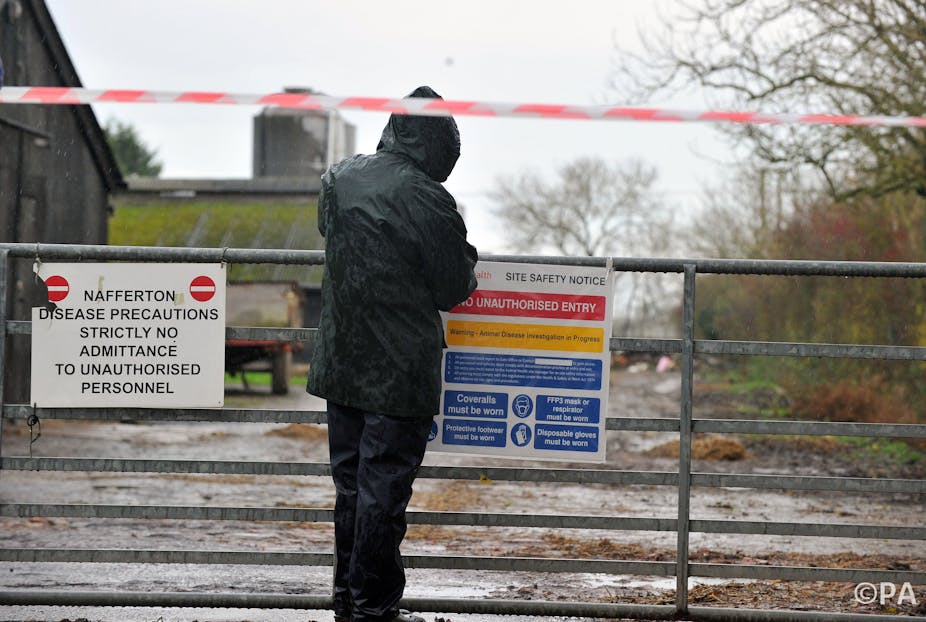A single case of avian influenza, also known as bird flu, has been confirmed at a farm in East Yorkshire. We still don’t know what strain of virus is behind it but health officials, and no doubt the public, will be extremely concerned that this infection doesn’t spread beyond a containment zone that has been set up. Like many zoonotic diseases, there is a question about whether this could potentially pose a risk to human health from the virus moving across the species barrier into people.
The Department for Environment, Food and Rural Affairs (DEFRA) has acted quickly by implementing a 10km exclusion zone and ordering the cull of around 6,000 birds in an attempt to prevent a wide-scale outbreak.
Outbreak in The Netherlands and Germany
The British case of avian influenza comes as health protection officials in The Netherlands dealt with an outbreak at a chicken farm on November 15, which was identified as the H5N8 strain of the virus. Dutch officials have followed a similar contain and cull procedure – in this case of 150,000 birds and scientists are now looking to see if the Yorkshire case is linked to this one.
It is still not yet clear yet how the outbreak at the Dutch poultry farm started but the H5N8 influenza virus was shown in Asia to have spread either through the import of infected poultry or by the seasonal migration of ducks.
Earlier in the month, H5N8 was also detected at a Turkey Farm in Germany – the first case of Avian influenza in Europe – and 30,000 birds were culled.
Critically, DEFRA has said that while the strain responsible for the Yorkshire bird flu case does indeed have the H5 protein, it is not H5N1, a highly pathogenic strain of influenza that is responsible for hundreds of deaths in south-east Asia.
It also means that the virus is also not the H7N9 strain, a novel strain of avian influenza that first appeared in March 2013 in China and which, according to the World Health Organisation, has infected 453 people to date, and claimed 175 lives, although no new cases have been reported recently. And while H7N9 did show a case of human-to-human transmission this really doesn’t happen very easily.
Risks to humans
The risk of these current avian influenza cases in Britain and The Netherlands causing major human influenza pandemics is extremely low. It is actually very difficult for humans to contract any strain of avian influenza as they tend to have to be in extended close contact with birds that are positive for a strain that is transmissible to humans. Because containment measures have been implemented at the site of the avian influenza case, then it is unlikely we will see any human cases infected with this strain at all, even in farm workers.
It has also been shown that none of the current circulating strains of avian influenza, including H5N1, can effectively transmit from human-to-human. That said, it is theoretically possible that mutations in the virus could occur, which could lead to airborne transmission.
The biggest concern that many people have when a novel virus is found to affect animals in the food chain is whether or not it can be contracted by eating contaminated food. The public should be reassured that there is no evidence that influenza is spread by eating food, as the route of infection is predominantly by inhalation (think symptoms of seasonal flu, sneezing and coughing). In any case, careful personal hygiene when handling raw meat and good cooking practices should destroy any pathogens present in the meat.
The challenges ahead
The greatest challenge facing officials responsible for protecting either public or livestock health is to prevent the spread of the virus beyond the containment zone. This will be accomplished by restricting access to the area, preventing transport of live poultry, and raising awareness of the infection among livestock workers.
A widespread cull will ensure that no live birds are able to act as conduits for the virus to escape to other farms. At the same time, the virus will be genetically sequenced in high containment laboratories, and tests will be conducted in order to determine how transmissible, and how pathogenic, this new virus actually is. The main thing now is not to panic.

